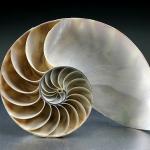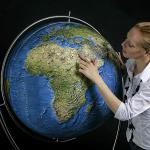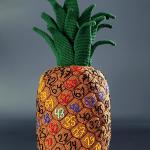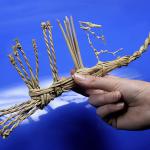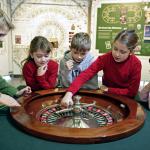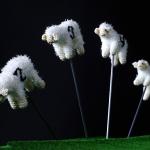EXTRA, the marketplace for scientific touring exhibitions.
Visitors will be able to experience a fascinating and always entertaining tour of the world of numbers. They approach the exhibition area on the escalator, accompanied by a countdown. On arrival at the top they are greeted by the video “Numbers on the move”. Its 5.000 images per second provide a vivid impression of the ubiquity and dynamics of numbers in our daily lives. Welcome to the world of numbers! The exhibition contains more than 300 exhibits, many screens and media stations.
(1.) Number Circus
First and foremost, this section is addressed to families. Visitors will be able to discover how to calculate the number pi by dropping jackstraws or gain an insight into the great significance of numbers in the world of music. Furthermore, toy calculators, geometric figures and a numbers drawer are all on display. People who want to try things out can tackle original number games.
(2.) The cultural history of numbers
In this section the visitor is taken back to ancient times to the civilisations on the Nile, Euphrates and Tigris rivers, whose early number systems marked the dawn of the age of arithmetic. Here a fascinating insight into a wide range of number systems and numerals is possible.
(3.) Masters of mathematics
The history of mathematics was shaped by individuals. Portraits of ten great masters of mathematics are on display, ranging from Pythagoras to Andrew Wiles. People can read the life history of each and for a closer look at their mathematical ability examples of their work can be viewed on the flip side of the story boards.
(4.) Surveying the world
Ever since man began to explore nature from a scientific perspective, numbers have been used to capture the details of the universe and of our planet.
There are several interesting objects from the past but also from the present, from the compass to the octant all the way to the atomic clock. Navigation has always gone hand in hand with measurement.
The significance of numbers in sea and weather charts is particularly striking. Visitors can try out a number telescope for land surveying purposes.
(5.) Numbers in nature
Numbers also play a significant role in nature. Leaves and fruits build spiral forms; the number of the left- and right-handed spirals is determined by a mathematical sequence known as the Fibonacci sequence. It leads to the proportional rule called the “golden section”, which not only determined the construction of ancient buildings, but also describes the form of the nautilus seashell.
Crystals are the only naturally occurring Platonic bodies. The diamond is perhaps the most beautiful example of all.
(6.) The theory of numbers
Visitors will get an insight into our present-day number system as well as other aspects of the world of numbers, for example natural numbers, rational, real and complex numbers. The world of numbers contains many special numbers, for example Pi, zero, and infinity.
(7.) Lucky numbers
Lottery, dice, roulette or black jack – statistically, the player has only two possibilities: either to lose or to cheat. It is the elements of luck and chance that make these games irresistible to many. Gambling has a bad reputation and is restricted, although the state earns a lot of money with it.
This section of the exhibition covers topics ranging from random numbers through conventional games of chance all the way to the art of card shuffling. You will find out which lottery tip is the most promising and why the trajectory of a roulette ball simply can’t be predicted, …or can it? The difficulty of generating random numbers is demonstrated by a number of technical constructions, including slot machines and a display of natural radioactive decay in the environment.
(8.) The ethnology of numbers
Numerals are among the oldest examples of human writing, but they are not based on the same system everywhere in the world. Many different methods of counting have been used during different time periods and by different cultures. In Germany, children start off with a base of ten, the origins of which can be traced back to the number of fingers on our hands. The people in Papau-New Guinea, for example, count up to 25 by pointing to various parts of their bodies. In some places people only count one, two, many.
(9.) Numbers in everyday life
Our daily life is dominated by numbers. The clock determines our everyday rhythm. Display boards give us data on airport departure times, flight numbers and expected delays. Visitors can observe a very interesting interactive media installation called “bit mirror”, which transforms images of people into numbers.
(10.) Animals and numbers
Lots of charming illustrations by Nadia Budde, a well-known author of children’s books, supply further proof that there is a connection between animals and numbers. Some animals develop a feeling for numerical proportions and a talent for identifying “greater or fewer”. Long time ago people thought that animals didn’t have any concept of numbers. But recent experiments show that rats can learn to count and to differentiate amounts. Research has proved that dolphins have some mathematical ability, they also can differentiate amounts. There were two amounts of symbols and the dolphins had to find out the smaller amount – they succeeded!


